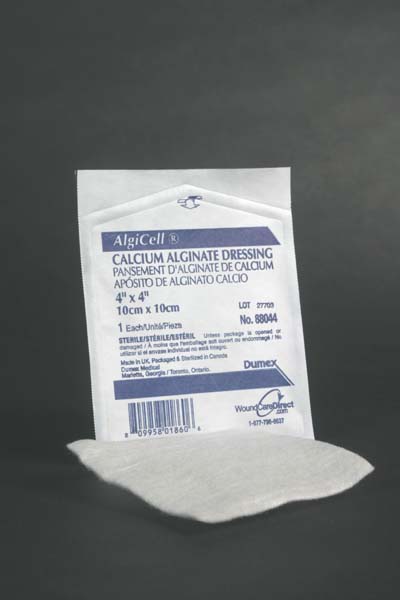Alginates
Alginate wound dressings are non-woven, non-adhesive pads and ribbons composed of natural polysaccharide fibers or xerogel derived from seaweed. On contact with exudate, these dressings form a moist gel through the process of ion exchange. They are soft and conformable, easy to pack, tuck or apply over irregularly shaped wounds. Indicated when there is moderate to heavy exudate, such as for pressure injuries, infected wounds and venous insufficiency ulcers. Alginates generally require a secondary dressing.
Alginate dressings are highly absorptive, non-occlusive dressings made of soft, non-woven calcium alginate fibers derived from brown seaweed or kelp. Alginate dressings are available as a primary dressing in pad or rope form. These dressings gel on contact with wound exudate, allowing for a moist wound environment and promoting autolytic debridement.
Alginate dressings feature the following general performance properties and attributes:
• Atraumatic removal
• Non-occlusive
• Can be cut to fit
• Can be layered for more absorption
• Bioabsorbable
• Can absorb up to 20 times their weight in exudate
Alginate dressings are indicated for use as a primary dressing in the treatment of moderately to heavily exuding partial- and full-thickness draining wounds such as stage III-IV pressure ulcers, dermal wounds, surgical incisions, dehisced wounds, tunneling wounds, sinus tracts, and donor sites. Alginates that contain silver can be used to manage infected wounds. Alginates can also provide hemostasis for postoperative wounds with minimal bleeding.
Alginate dressings are contraindicated for use on dry eschar, third-degree burns, for surgical implantation, or wounds with heavy bleeding.
The following general warnings apply to alginate dressings. Always refer to manufacturer information for Warnings and Precautions for a specific product.
May dehydrate wound bed.
Not appropriate for dry wounds.
Due to low tensile strength, avoid packing in narrow, deep sinuses.
May require secondary dressing to secure.
May be malodorous during dressing change.
May leave fibers in wound bed if drainage is insufficient to fully gel the product.
Products
Pagination
Have a product to submit?
Be included in the most comprehensive wound care products directory
and online database.
Learn More
















